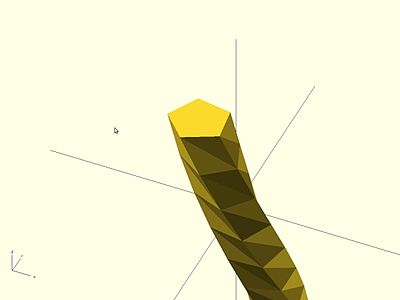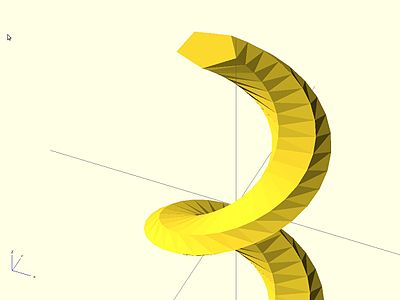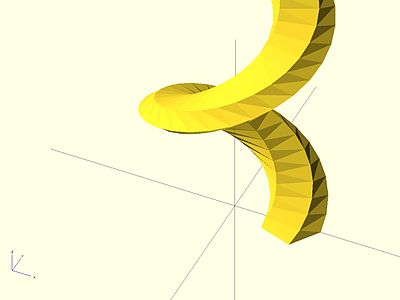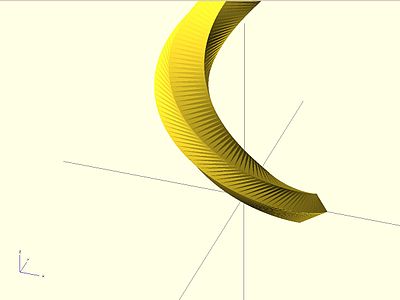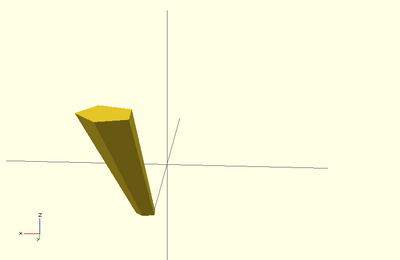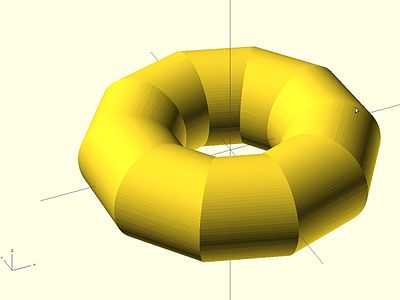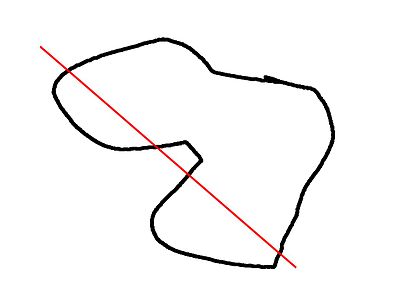OpenSCAD用户手册/2D 到 3D 拉伸
挤压成型是以固定截面形状来创建工件的一道工序。OpenSCAD为从2D形状创建3D实体提供了两种命令:linear_extrude()与rotate_extrude()。线性挤型就如同把橡皮泥放入特定形状的模具,再通过挤压成型。

旋转挤型就类似于在陶轮上制作碗的过程。Potter's wheel.

两种挤型方法处理的目标都是位于X-Y平面上的(可能是不连续的)2D几何图形。While transformations that operates on both 2D shapes and 3D solids can move a shape off the X-Y plane, when the extrusion is performed the end result is not very intuitive. What actually happens is that any information in the third coordinate (the Z coordinate) is ignored for any 2D shape, this process amounts to an implicit projection() performed on any 2D shape before the extrusion is executed. It is recommended to perform extrusion on shapes that remains strictly on the X-Y plane.
线性挤型
[编辑]线性挤型(Linear Extrusion)是一种以2D多边形作为输入,并令其在3D空间进行扩展的建模操作。这样,就可创建出一个3D几何形状。请牢记,挤型总是以XY平面开始,并按照高度的指示沿Z轴来挤压3D形状;因此,如果您在挤型之前运用了旋转或其他变换的话,挤型函数将依照2D多边形在XY平面上的投影进行处理。
用法
[编辑]linear_extrude(height = fanwidth, center = true, convexity = 10, twist = -fanrot, slices = 20, scale = 1.0, $fn = 16) {...}
由于向后兼容的问题,您必须使用参数名。
height必须为正数。
$fn是指定linear_extrude分辨率的可选项(值越大图形越“平滑”,但计算时间也将随之增加)。
If the extrusion fails for a non-trivial 2D shape, try setting the convexity parameter (the default is not 10, but 10 is a "good" value to try). See explanation further down.
Twist
[编辑]Twist is the number of degrees of through which the shape is extruded. Setting the parameter twist = 360 will extrude through one revolution. The twist direction follows the left hand rule.
0° of Twist
linear_extrude(height = 10, center = true, convexity = 10, twist = 0) translate([2, 0, 0]) circle(r = 1);
-100° of Twist
linear_extrude(height = 10, center = true, convexity = 10, twist = -100) translate([2, 0, 0]) circle(r = 1);
100° of Twist
linear_extrude(height = 10, center = true, convexity = 10, twist = 100) translate([2, 0, 0]) circle(r = 1);
-500° of Twist
linear_extrude(height = 10, center = true, convexity = 10, twist = -500) translate([2, 0, 0]) circle(r = 1);
Center
[编辑]It is similar to the parameter center of cylinders. If center is false the linear extrusion Z range is from 0 to height; if it is true, the range is from -height/2 to height/2.
center = true
linear_extrude(height = 10, center = true, convexity = 10, twist = -500) translate([2, 0, 0]) circle(r = 1);
center = false
linear_extrude(height = 10, center = false, convexity = 10, twist = -500) translate([2, 0, 0]) circle(r = 1);
Mesh Refinement
[编辑]The slices parameter defines the number of intermediate points along the Z axis of the extrusion. Its default increases with the value of twist. Explicitly setting slices may improve the output refinement.
linear_extrude(height = 10, center = false, convexity = 10, twist = 360, slices = 100) translate([2, 0, 0]) circle(r = 1);
The special variables $fn, $fs and $fa can also be used to improve the output. If slices is not defined, its value is taken from the defined $fn value.
linear_extrude(height = 10, center = false, convexity = 10, twist = 360, $fn = 100) translate([2, 0, 0]) circle(r = 1);
Scale
[编辑]Scales the 2D shape by this value over the height of the extrusion. Scale can be a scalar or a vector:
linear_extrude(height = 10, center = true, convexity = 10, scale=3) translate([2, 0, 0]) circle(r = 1);
linear_extrude(height = 10, center = true, convexity = 10, scale=[1,5], $fn=100) translate([2, 0, 0]) circle(r = 1);
Note that if scale is a vector, the resulting side walls may be nonplanar. Use twist=0 and the slices parameter to avoid asymmetry.
linear_extrude(height=10, scale=[1,0.1], slices=20, twist=0) polygon(points=[[0,0],[20,10],[20,-10]]);
Rotate Extrude
[编辑]Rotational extrusion spins a 2D shape around the Z-axis to form a solid which has rotational symmetry. One way to think of this operation is to imagine a Potter's wheel placed on the X-Y plane with its axis of rotation pointing up towards +Z. Then place the to-be-made object on this virtual Potter's wheel (possibly extended down below the X-Y plane towards -Z, take the cross-section of this object on the X-Z plane but keep only the right half (X >= 0). That is the 2D shape that need to be fed to rotate_extrude() as the child in order to generate this solid.
Since a 2D shape is rendered by OpenSCAD on the X-Y plane, an alternative way to think of this operation is as follows: spins a 2D shape around the Y-axis to form a solid. The resultant solid is placed so that its axis of rotation lies along the Z-axis.
It can not be used to produce a helix or screw threads.
The 2D shape needs to lie completely on either the right (recommended) or the left side of the Y-axis. More precisely speaking, each vertex of the shape must have either x >= 0 or x <= 0. If the shape crosses the X axis a warning will be shown in the console windows and the rotate_extrude() will be ignored. For OpenSCAD versions prior to 2016.xxxx, if the shape is in the negative axis the faces will be inside-out, which may cause undesired effects.
参数
用法
[编辑]rotate_extrude(angle = 360, convexity = 2) {...}
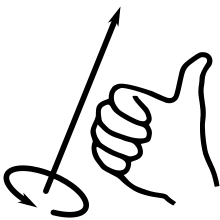
You must use parameter names due to a backward compatibility issue.
- convexity
- If the extrusion fails for a non-trival 2D shape, try setting the convexity parameter (the default is not 10, but 10 is a "good" value to try). See explanation further down.
- angle [请注意: 需要使用版本 2015.09]
- Defaults to 360. Specifies the number of degrees to sweep, starting at the positive X axis. The direction of the sweep follows the Right Hand Rule, hence a negative angle will sweep clockwise.
示例
[编辑]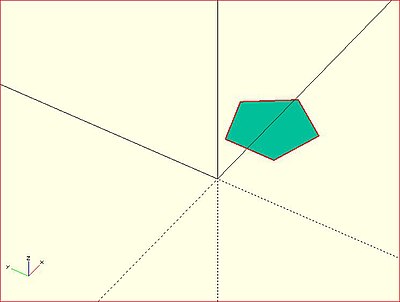
A simple torus can be constructed using a rotational extrude.
rotate_extrude(convexity = 10) translate([2, 0, 0]) circle(r = 1);
Mesh Refinement
[编辑]
Increasing the number of fragments that the 2D shape is composed of will improve the quality of the mesh, but take longer to render.
rotate_extrude(convexity = 10) translate([2, 0, 0]) circle(r = 1, $fn = 100);

The number of fragments used by the extrusion can also be increased.
rotate_extrude(convexity = 10, $fn = 100) translate([2, 0, 0]) circle(r = 1, $fn = 100);
Using the parameter angle (with OpenSCAD versions 2016.xx), a hook can be modeled .

translate([0,60,0])
rotate_extrude(angle=270, convexity=10)
translate([40, 0]) circle(10);
rotate_extrude(angle=90, convexity=10)
translate([20, 0]) circle(10);
translate([20,0,0])
rotate([90,0,0]) cylinder(r=10,h=80);
Extruding a Polygon
[编辑]Extrusion can also be performed on polygons with points chosen by the user.
Here is a simple polygon and its 200 step rotational extrusion. (Note it has been rotated 90 degrees to show how the rotation will look; the rotate_extrude() needs it flat).
rotate([90,0,0]) polygon( points=[[0,0],[2,1],[1,2],[1,3],[3,4],[0,5]] );
rotate_extrude($fn=200) polygon( points=[[0,0],[2,1],[1,2],[1,3],[3,4],[0,5]] );

For more information on polygons, please see: 2D Primitives: Polygon.
挤型参数的相关描述
[编辑]针对所有挤型模式的挤型参数
[编辑]| convexity | Integer. The convexity parameter specifies the maximum number of front sides (back sides) a ray intersecting the object might penetrate.
This parameter is only needed for correctly displaying the object in OpenCSG preview mode and has no effect on the polyhedron rendering. |
This image shows a 2D shape with a convexity of 4, as the ray indicated in red crosses the 2D shape a maximum of 4 times. The convexity of a 3D shape would be determined in a similar way. Setting it to 10 should work fine for most cases.
仅用于线性挤型的挤型参数
[编辑]| height | The extrusion height |
| center | If true the solid will be centered after extrusion |
| twist | The extrusion twist in degrees |
| slices | Similar to special variable $fn without being passed down to the child 2D shape. |
| scale | Scales the 2D shape by this value over the height of the extrusion. |



